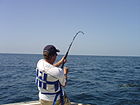
Trout is a generic common name for numerous species of carnivorous freshwater ray-finned fishes belonging to the genera Oncorhynchus, Salmo and Salvelinus, all of which are members of the subfamily Salmoninae in the family Salmonidae. The word trout is also used for some similar-shaped but non-salmonid fish, such as the spotted seatrout/speckled trout.

Fly fishing is an angling technique that uses an ultra-lightweight lure called an artificial fly, which typically mimics small invertebrates such as flying and aquatic insects to attract and catch fish. Because the mass of the fly lure is insufficient to overcome air resistance, it cannot be launched far using conventional gears and techniques, so specialized tackles are used instead and the casting techniques are significantly different from other forms of angling. It is also very common for the angler to wear waders, carry a hand net, and stand in the water when fishing.

Crappies are two species of North American freshwater fish of the genus Pomoxis in the family Centrarchidae (sunfishes). Both species of crappies are popular game fish among recreational anglers.

Big-game fishing, also known as offshore sportfishing, offshore gamefishing or blue-water fishing, is a form of recreational fishing targeting large game fish, usually on a large body of water such as a sea or ocean.

Recreational fishing, also called sport fishing or game fishing, is fishing for leisure, exercise or competition. It can be contrasted with commercial fishing, which is professional fishing for profit; or subsistence fishing, which is fishing for survival and livelihood.
Siberian taimen, also known as the common taimen, Siberian giant trout or Siberian salmon, is a species of salmon-like ray-finned fish from the genus Hucho in the family Salmonidae. These fish are found in rivers in Siberia and adjacent regions, and are harvested throughout the year.

The Australian grayling is a primarily freshwater fish found in coastal rivers in south-eastern mainland Australia and Tasmania. In past decades it has also been known as the cucumber mullet or cucumber herring, for its cucumber-like odour.

Sea trout is the common name usually applied to anadromous (sea-run) forms of brown trout, and is often referred to as Salmo trutta morpha trutta. Other names for anadromous brown trout are bull trout, sewin (Wales), peel or peal, mort, finnock (Scotland), white trout (Ireland), Dollaghan and salmon trout (culinary).

The International Game Fish Association (IGFA) is the leading authority on angling pursuits and the keeper of the most current world record fishing catches by fish categories. Fishermen who are sport fishers are careful to follow their stringent rules for fair play and line requirements in order to receive the honor of being listed in their annual "World Record Game Fishes" publication. The publication also gives fishing tips, and has an extensive fish identification guide. The IGFA is also an ardent proponent of aquatic habitat conservation, and cooperates with biologists all over the world.

Coarse fishing is a phrase commonly used in Britain and Ireland. It refers to the angling for rough fish, which are fish species considered undesirable as food or game fish. Freshwater game fish are all salmonids, particularly salmon, trout and char. Generally, coarse fish are freshwater fish that are not salmonids, though there is often disagreement over whether grayling should be classified as a game fish or a coarse fish.

An artificial fly or fly lure is a type of fishing lure, usually used in the sport of fly fishing. In general, artificial flies are an imitation of aquatic insects that are natural food of the target fish species the fly fishers try to catch. Artificial flies are constructed by fly tying, in which furs, feathers, thread or any of very many other materials are tied onto a fish hook.

A game fish is any species of fish pursued for sport by recreationalists (anglers). The capture of game fish is usually tightly regulated. In comparison, nongame fish are all fish not considered game fish. Game fish may be eaten after being caught, though increasingly anglers are practicing catch-and-release tactics to improve fish populations.
Rough fish is a term used by some United States state agencies and anglers to describe fish that are less desirable to sport anglers within a defined region. The term usually refers to larger game fish species that are not commonly eaten, are too rare to be commonly encountered, or are not favorably sought by anglers for sporting purposes. Many of these species are actually very important in the commercial fishing industry, where they make up the bulk of commercial food fish catches in inland freshwater bodies.
A fishing tournament, or Angling tournament, is an organised competition among anglers. Fishing tournaments typically take place as a series of competitive events around or on a clearly defined body of water with specific rules applying to each event. They can take place on or along the edge of oceans, lakes, rivers, including ice covered bodies of water.
This page is a list of fishing topics.
The following outline is provided as an overview of and topical guide to fishing:

This is an impartial and comprehensive record list of 308 British record freshwater fish, past and present, involving 60 different species/sub-species of fish caught using the traditional angling method of rod and line. Records to include the angler, species, weight, date, venue, also referenced with a recognizable publication. The list is intended to include all categories of fish caught by anglers, that enter freshwater including and some migratory sea fish. The time since last record fish was caught is 160 days.





















